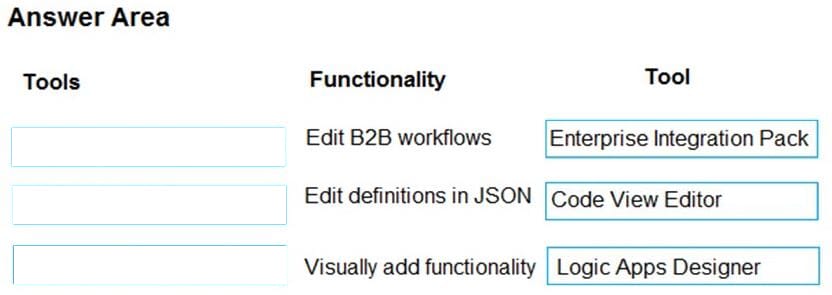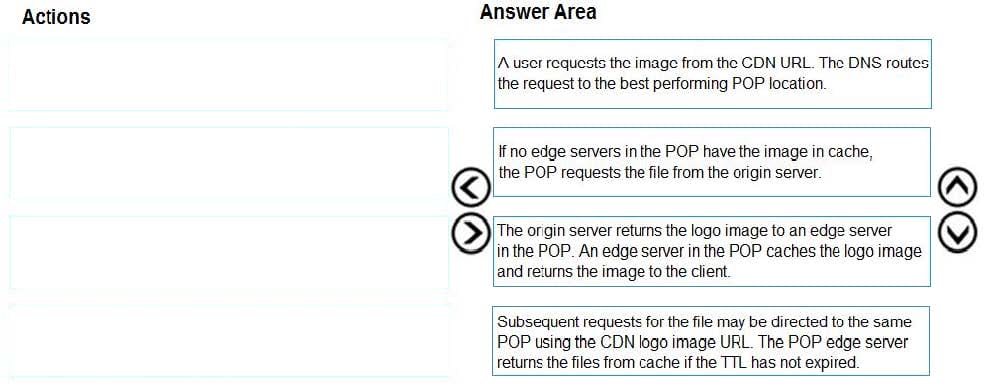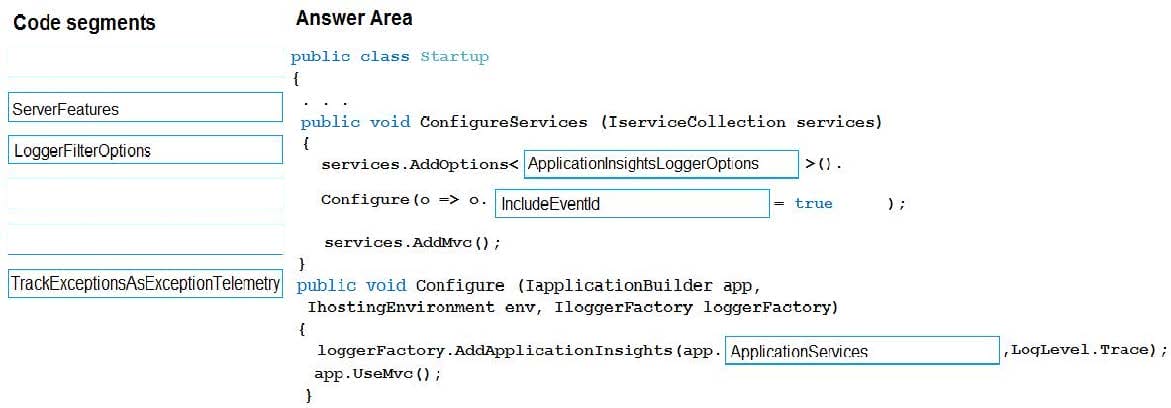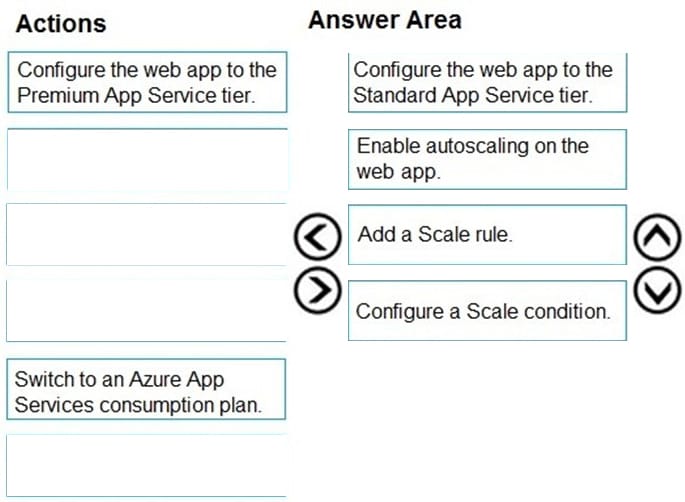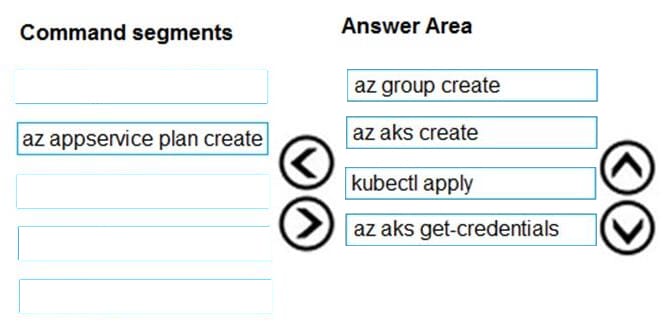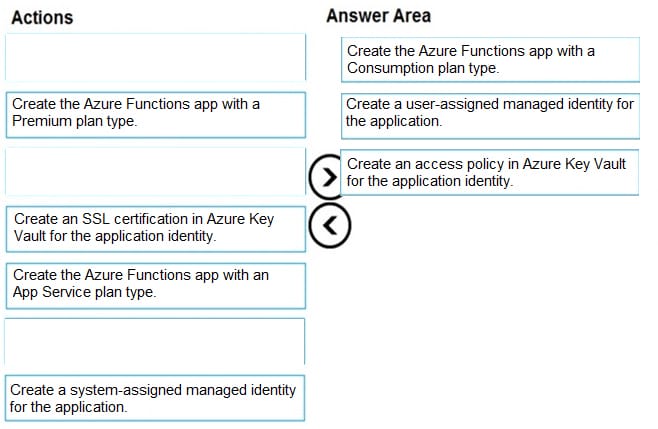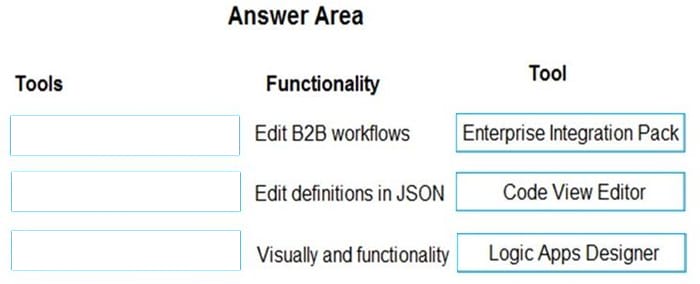Exam Details
Exam Code
:AZ-204Exam Name
:Developing Solutions for Microsoft AzureCertification
:Microsoft CertificationsVendor
:MicrosoftTotal Questions
:532 Q&AsLast Updated
:Apr 12, 2025
Microsoft Microsoft Certifications AZ-204 Questions & Answers
-
Question 241:
DRAG DROP
You manage several existing Logic Apps.
You need to change definitions, add new logic and optimize these apps on a regular basis.
What should you use? To answer, drag the appropriate tools to the coned functionalities. Each tool may be used once, more than once, or not at all- You may need to drag the split bar between panes or scroll to view content.
NOTE: Each correct selection is worth one point.
Select and Place:
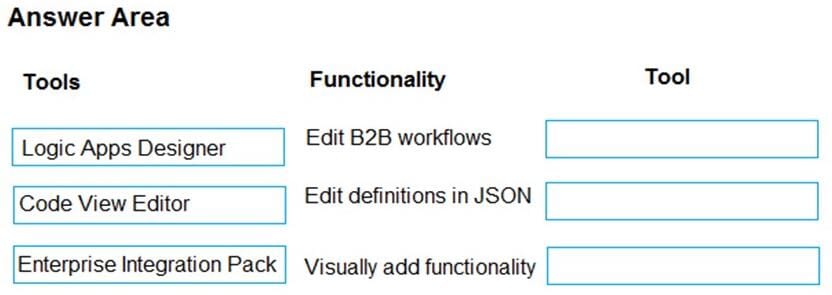
-
Question 242:
DRAG DROP
Your company has several websites that use a company logo image. You use Azure Content Delivery Network (CDN) to store the static image.
You need to determine the correct process of how the CDN and the Point of Presence (POP) server will distribute the image and list the items in the correct order.
In which order do the actions occur? To answer, move all actions from the list of actions to the answer area and arrange them in the correct order.
Select and Place:
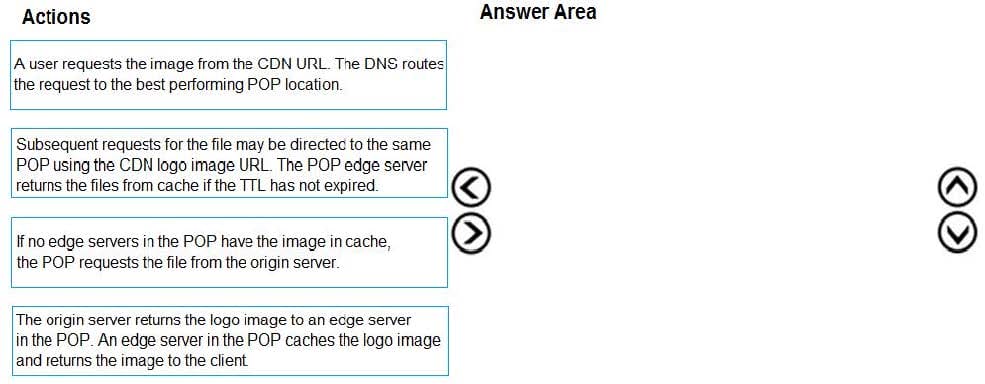
-
Question 243:
DRAG DROP
You are developing an ASP.NET Core Web API web service that uses Azure Application Insights to monitor performance and trade events.
You need to enable logging and ensure that log messages can be correlated to events tracked by Application Insights.
How should you complete the code? To answer, drag the appropriate code segments to the correct locations.
Each code segment may be used once, more than once, or not at alt. You may need to drag the split bar between panes or scroll to view content.
NOTE: Each correct selection is worth one point.
Select and Place:

-
Question 244:
DRAG DROP
You develop a web app that uses tier D1 app service plan by using the Web Apps feature of Microsoft Azure App Service.
Spikes in traffic have caused increases in page load times.
You need to ensure that the web app automatically scales when CPU load is about 85 percent and minimize costs.
Which four actions should you perform in sequence? To answer, move the appropriate actions from the list of actions to the answer area and arrange them in the correct order.
NOTE: More than one order of answer choices is correct. You will receive credit for any of the correct orders you select.
Select and Place:

-
Question 245:
DRAG DROP
You are deploying an Azure Kubernetes Services (AKS) cluster that will use multiple containers
You need to create the cluster and verify that the services for the containers are configured correctly and available.
Which four commands should you use to develop the solution? To answer, move the appropriate command segments from the list of command segments to the answer area and arrange them in the correct order.
Select and Place:
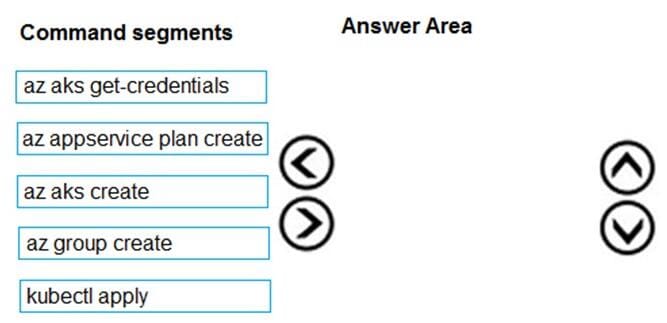
-
Question 246:
DRAG DROP
You are developing a serverless Java application on Azure. You create a new Azure Key Vault to work with secrets from a new Azure Functions application.
The application must meet the following requirements:
1.
Reference the Azure Key Vault without requiring any changes to the Java code.
2.
Dynamically add and remove instances of the Azure Functions host based on the number of incoming application events.
3.
Ensure that instances are perpetually warm to avoid any cold starts.
4.
Connect to a VNet.
5.
Authentication to the Azure Key Vault instance must be removed if the Azure Function application is deleted.
You need to grant the Azure Functions application access to the Azure Key Vault.
Which three actions should you perform in sequence? To answer, move the appropriate actions from the list of actions to the answer area and arrange them in the correct order.
Select and Place:
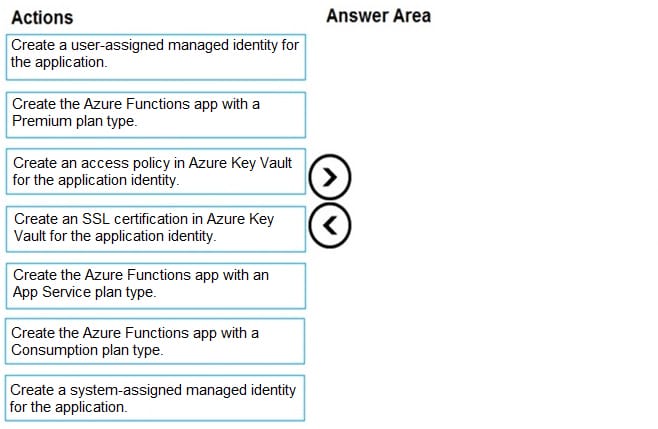
-
Question 247:
DRAG DROP
A web service provides customer summary information for e-commerce partners. The web service is implemented as an Azure Function app with an HTTP trigger. Access to the API is provided by an Azure API Management instance. The API
Management instance is configured in consumption plan mode. All API calls are authenticated by using OAuth.
API calls must be cached. Customers must not be able to view cached data for other customers.
You need to configure API Management policies for caching.
How should you complete the policy statement?
Select and Place:

-
Question 248:
DRAG DROP
You manage several existing Logic Apps.
You need to change definitions, add new logic, and optimize these apps on a regular basis.
What should you use? To answer, drag the appropriate tools to the correct functionalities. Each tool may be used once, more than once, or not at all. You may need to drag the split bar between panes or scroll to view content.
NOTE: Each correct selection is worth one point.
Select and Place:

-
Question 249:
You develop and deploy a web app to Azure App Service. The Azure App Service uses a Basic plan in a single region.
Users report that the web app is responding slow. You must capture the complete call stack to help identify performance issues in the code. Call stack data must be correlated across app instances. You must minimize cost and impact to
users on the web app.
You need to capture the telemetry.
Which three actions should you perform? Each correct answer presents part of the solution.
NOTE: Each correct selection is worth one point.
A. Restart all apps in the App Service plan.
B. Enable Application Insights site extensions.
C. Upgrade the Azure App Service plan to Premium.
D. Enable Profiler.
E. Enable the Always On setting for the app service.
F. Enable Snapshot debugger.
G. Enable remote debugging.
-
Question 250:
You are building a B2B web application that uses Azure B2B collaboration for authentication. Paying customers authenticate to Azure B2B using federation.
The application allows users to sign up for trial accounts using any email address.
When a user converts to a paying customer, the data associated with the trial should be kept, but the user must authenticate using federation.
You need to update the user in Azure Active Directory (Azure AD) when they convert to a paying customer.
Which Graph API parameter is used to change authentication from one-time passcodes to federation?
A. resetRedemption
B. Status
C. userFlowType
D. invitedUser
Related Exams:
62-193
Technology Literacy for Educators70-243
Administering and Deploying System Center 2012 Configuration Manager70-355
Universal Windows Platform – App Data, Services, and Coding Patterns77-420
Excel 201377-427
Excel 2013 Expert Part One77-725
Word 2016 Core Document Creation, Collaboration and Communication77-726
Word 2016 Expert Creating Documents for Effective Communication77-727
Excel 2016 Core Data Analysis, Manipulation, and Presentation77-728
Excel 2016 Expert: Interpreting Data for Insights77-731
Outlook 2016 Core Communication, Collaboration and Email Skills
Tips on How to Prepare for the Exams
Nowadays, the certification exams become more and more important and required by more and more enterprises when applying for a job. But how to prepare for the exam effectively? How to prepare for the exam in a short time with less efforts? How to get a ideal result and how to find the most reliable resources? Here on Vcedump.com, you will find all the answers. Vcedump.com provide not only Microsoft exam questions, answers and explanations but also complete assistance on your exam preparation and certification application. If you are confused on your AZ-204 exam preparations and Microsoft certification application, do not hesitate to visit our Vcedump.com to find your solutions here.
